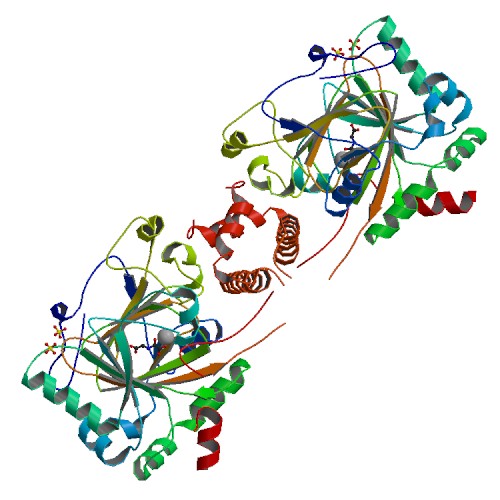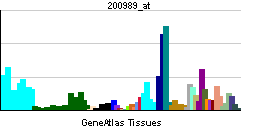HIF1A
Hypoxia-inducible factor 1, alpha subunit (basic helix-loop-helix transcription factor), also known as HIF1A, is a human gene.
| Hypoxia-inducible factor 1, alpha subunit (basic helix-loop-helix transcription factor) | |||||||||||||
|---|---|---|---|---|---|---|---|---|---|---|---|---|---|
 PDB rendering based on 1h2k. | |||||||||||||
| |||||||||||||
| Identifiers | |||||||||||||
| Symbols | HIF1A ; HIF-1alpha; HIF1-ALPHA; MOP1; PASD8 | ||||||||||||
| External IDs | Template:OMIM5 Template:MGI HomoloGene: 1171 | ||||||||||||
| |||||||||||||
| RNA expression pattern | |||||||||||||
 | |||||||||||||
| More reference expression data | |||||||||||||
| Orthologs | |||||||||||||
| Template:GNF Ortholog box | |||||||||||||
| Species | Human | Mouse | |||||||||||
| Entrez | n/a | n/a | |||||||||||
| Ensembl | n/a | n/a | |||||||||||
| UniProt | n/a | n/a | |||||||||||
| RefSeq (mRNA) | n/a | n/a | |||||||||||
| RefSeq (protein) | n/a | n/a | |||||||||||
| Location (UCSC) | n/a | n/a | |||||||||||
| PubMed search | n/a | n/a | |||||||||||
The protein encoded by HIF1 is a transcription factor found in mammalian cells growing at low oxygen concentrations. It plays an essential role in cellular and systemic responses to hypoxia.[1] This is one of the class of hypoxia inducible factors.
HIF1 is a heterodimer composed of an alpha subunit and a beta subunit. The beta subunit has been identified as the aryl hydrocarbon receptor nuclear translocator (ARNT). This gene encodes the alpha subunit of HIF-1. Overexpression of a natural antisense transcript (aHIF) of this gene is associated with nonpapillary renal carcinomas.[2] Two alternative transcripts encoding different isoforms have been identified.[3]
References
- ↑ Ratcliffe PJ (2003). "From erythropoietin to oxygen: hypoxia-inducible factor hydroxylases and the hypoxia signal pathway". Blood Purif. 20 (5): 445–50. PMID 12207089.
- ↑ Quintero M, Mackenzie N, Brennan PA (2004). "Hypoxia-inducible factor 1 (HIF-1) in cancer". Eur J Surg Oncol. 30 (5): 465–8. doi:10.1016/j.ejso.2004.03.008. PMID 15135470.
- ↑ "Entrez Gene: HIF1A hypoxia-inducible factor 1, alpha subunit (basic helix-loop-helix transcription factor)".
Further reading
- Semenza GL (2000). "HIF-1 and human disease: one highly involved factor". Genes Dev. 14 (16): 1983–91. PMID 10950862.
- Semenza G (2002). "Signal transduction to hypoxia-inducible factor 1". Biochem. Pharmacol. 64 (5–6): 993–8. PMID 12213597.
- Arbeit JM (2003). "Quiescent hypervascularity mediated by gain of HIF-1 alpha function". Cold Spring Harb. Symp. Quant. Biol. 67: 133–42. PMID 12858534.
- Sitkovsky M, Lukashev D (2005). "Regulation of immune cells by local-tissue oxygen tension: HIF1 alpha and adenosine receptors". Nat. Rev. Immunol. 5 (9): 712–21. doi:10.1038/nri1685. PMID 16110315.
- Mobasheri A, Richardson S, Mobasheri R; et al. (2006). "Hypoxia inducible factor-1 and facilitative glucose transporters GLUT1 and GLUT3: putative molecular components of the oxygen and glucose sensing apparatus in articular chondrocytes". Histol. Histopathol. 20 (4): 1327–38. PMID 16136514.
- Schipani E (2006). "Hypoxia and HIF-1 alpha in chondrogenesis". Semin. Cell Dev. Biol. 16 (4–5): 539–46. doi:10.1016/j.semcdb.2005.03.003. PMID 16144691.
- Haase VH (2006). "Hypoxia-inducible factors in the kidney". Am. J. Physiol. Renal Physiol. 291 (2): F271–81. doi:10.1152/ajprenal.00071.2006. PMID 16554418.
- Liang D, Kong X, Sang N (2007). "Effects of histone deacetylase inhibitors on HIF-1". Cell Cycle. 5 (21): 2430–5. PMID 17102633.
| This protein-related article is a stub. You can help Wikipedia by expanding it. |